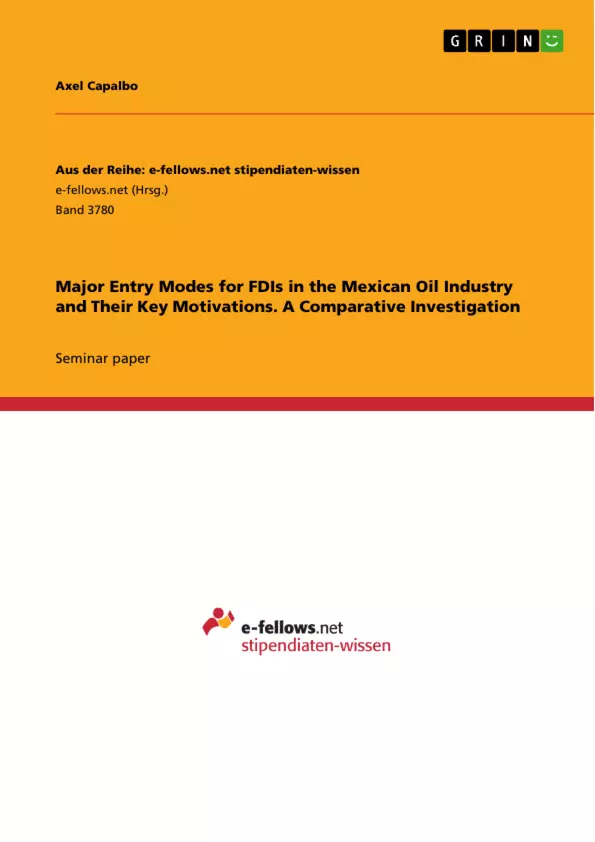The present report reflects a profound evaluation of the performance, change and the economic-political relation between the government and foreign investors in one of the most prosperous and untouched oil markets: Mexico. Its oil market, whose growth in value is estimated to attain $54.9 billion in 2021, is equal to an increase of 79.4% since 2016.
The origin of this object of research is attributable to two drivers. On the one hand, the subchapter about the extractive industries from the module’s core reading "Global Shift" by Peter Dicken served as a starting point for the corresponding analysis. In contrast to this basic reference, the scope is narrowed down to the oil sector for the sake of a more concise and precise investigation. On the other hand, the topic as such deserves a closer examination due to the relevant, dynamic transformation process within a promising emerging economy, stimulated by governmental reforms from the past ten years enabling the liberalisation for the benefit of foreign MNCs.
With this in mind, there arises the question of major entry modes practised by global players in the meantime to penetrate the Mexican oil sector. The corresponding answer provided in this document is structured as follows.
The first chapter consists of a preview comprising the entire metamorphosis of the Mexican oil industry, starting with an overview of the formerly predominant conditions, continuing with a description of the recent energy reforms and their consequences, and ending with an outline of the latest modes of entry. In addition, these subchapters are informed with information on both the past and the present role of the Mexican nation-state, accompanied by strategic adjustments implemented by prominent intercontinental players at the respective time.
Subsequently, the focus shifts towards the analytical core embedded in the second chapter. At this point, the contents draw mostly on theoretical frameworks related to the previously characterised modes of entry, allowing an ad hoc classification and juxtaposition of the FDIs, the key motivations to internationalise as well as of the anticipated advantages behind the entrepreneurial initiatives.
Ultimately, all the aforementioned insights and key arguments are summarised in a brief concluding chapter.
Inhaltsverzeichnis (Table of Contents)
- Introduction to the object of investigation
- 1. Preview: The transformation of the Mexican oil industry
- 1.1 Formerly predominant conditions
- 1.2 The recent energy reforms and their consequences
- 2. Comparative analysis between the past and the current modes of entry
- 2.1 Juxtaposition of entry modes
- 2.1.1 Past attempts
- 2.1.2 Currently planned attempts
- 2.2 Probable key motives behind the selected entry modes and prospective advantages
- 2.2.1 Key motivations
- 2.2.2 Expected advantages
- 2.1 Juxtaposition of entry modes
- Conclusion
Zielsetzung und Themenschwerpunkte (Objectives and Key Themes)
This report examines the evolution of the Mexican oil industry, focusing on the interplay between government policy and foreign investment. It analyzes the major entry modes employed by foreign companies in the sector, particularly since the recent energy reforms. The report explores the motivations behind these entry modes, highlighting the potential advantages and challenges they present.
- The transformation of the Mexican oil industry from a protectionist regime to a more open market.
- The impact of energy reforms on attracting foreign direct investment (FDI).
- Comparative analysis of past and present entry modes utilized by international players in the Mexican oil sector.
- Key motivations driving FDI in the Mexican oil industry.
- Potential advantages and challenges associated with different entry modes.
Zusammenfassung der Kapitel (Chapter Summaries)
The first chapter provides an overview of the Mexican oil industry's transformation, outlining the historical context of protectionist policies and the recent changes spurred by energy reforms. It examines the impact of these reforms on the role of the Mexican government and the strategic responses of international players.
The second chapter dives into a comparative analysis of entry modes, juxtaposing past attempts with currently planned initiatives. It explores the key motivations behind these choices, examining both the drivers for internationalization and the anticipated benefits for foreign companies.
Schlüsselwörter (Keywords)
The key terms and concepts explored in this report include: Mexican oil industry, energy reforms, foreign direct investment (FDI), entry modes, internationalization, key motivations, anticipated advantages, protectionist policies, government policies, strategic adjustments, emerging economies, and nationalization.
- Quote paper
- Axel Capalbo (Author), 2017, Major Entry Modes for FDIs in the Mexican Oil Industry and Their Key Motivations. A Comparative Investigation, Munich, GRIN Verlag, https://www.grin.com/document/1010171



